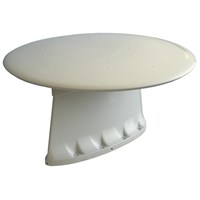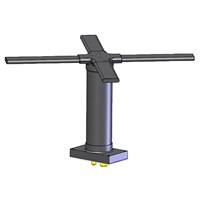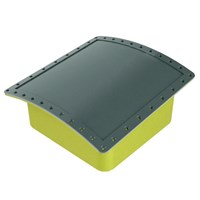All about UHF SATCOM
Can a polar bear in the Arctic communicate with a penguin in the Antarctic? It's possible with UHF SATCOM

Communication has always played an important role in the digital battlefield; as technologies and warfare become more sophisticated, it's proving to be even more critical.
The Ultra High Frequency Satellite Communications (uhf satcom) System provides communication links, via satellite, between designated mobile units and shore sites worldwide in the Ultra High Frequency band beyond the line of sight. It is immune to weather issues and can penetrate deep forest cover. The system is mostly used by ground troops in the form of portable "manpacks" but is also utilised by aircraft and naval vessels when they travel outside the High Frequency (HF) and Very High Frequency (VHF) line-of-sight range.
UHF satcom makes use of Geosynchronous Earth Orbit satellite; Geo as in 'Earth' and Synchronous as in 'at the same time'. The four geosynchronous, or geostationary, satellites are placed where the angular velocity of the satellite is the same as the angular velocity of the Earth giving the appearance that the satellite is fixed in space. Actually, it moves in line with the Earth's circular orbit. Great for ground antennas that don't need to move, but not so much for those that do.

ufh satcom (or UHF Follow On System) antennas enable Line-of-Sight communications by transmitting to one of the geostationary satellites. The signal was received and processed by the transmitter and then sent to the intended receiver after some limited modulation. However, ufh satcom is limited in its ability to re-use the geostationary arc and struggles with Beyond-Line-of-Sight Communications. So from the Arctic to the Antarctic, snail mail may have to be relied upon.
Another major challenge the battlefield faces is the ability for all the different technologies used by the military to operate seamlessly. You can imagine just how high the volume of data that has to flow back and forth is, sometimes over thousands of miles – all without interruption or bottlenecks. MUOS will be able to tackle this and ensure continuity and interoperability of communications.
SATCOM, or Satellite Communications, refers to the voice and data service which allows an aircraft, ground soldier or naval vessel to communicate with its team both in the air and on the ground when outside or beyond the line of sight of conventional high frequency stations.
Mostly used by governments and military agencies, SATCOM provides users with clear voice and data communications both in the line-of-sight and beyond. Military uhf satcom benefits from a high level of interoperability and are useful for multinational operations. Lightweight and robust, uhf satcom provides a highly secure means of communication with extensive uses on land, at sea and in the air to meet the needs of the armed forced.
satcom antenna have a monogamous relationship with satellites in that they only talk to one antenna. An Earth station antenna can point towards this satellite but could you imagine a soldier or fighter pilot having to tilt a certain way just to get a signal? Instead, uhf satcom allows the pilot of a fighter jet to switch between high and low angle beams to ensure the strongest signal is maintained.




One of your five a day, this mushroom shaped antenna comprises a pair of crossed folded dipoles fed in phase quadrature to achieve right hand polarisation. The flange at the bond line provides the mounting interface with the airframe and has a conductive finish for good electrical bonding. Mushroom antennas can also provide low angle coverage in some cases. Also available as muos antenna

Designed for SATCOM on the move, the X-wing antenna shape provides hemispheric pattern coverage through the use of two independent co-located elements built into a single, aerodynamic shell. Can also provide low angle coverage in some cases.

Conformal antennas are exactly as described, in that they conform to the skin of the aircraft so they are not seen. These are none invasive and unlike a protruding antenna and are less susceptible to damage during flight or ground movement.
The Mobile User Objective System (MUOS) has been developed to complement the US military’s current narrowband tactical communications system known as the Ultra High Frequency Follow-on system – UFO for short.
The MUOS space and ground segments consist of five orbiting satellites (one is a spare satellite) and four ground stations respectively. In this system, which mimics a cellular-like service, the satellites effectively act as cell towers to support communication. The user segment comprises of UHF radios, which have been upgraded to support the new MUOS Wideband Code Division Multiple Access (WCDMA) waveform. MUOS-capable radios, accompanied by muos antenna, are and will be installed on aircraft, ships, and ground platforms, and are used by dismounted soldiers to enable beyond line of sight (BLOS) communications.
Built around the commercial 3G cellular technology, MUOS improves the performance of the network system and has a capacity 10 times greater than the legacy UFO SATCOM. It enables voice, video and data transmission over a secure, high-speed Internet Protocol (IP) based and net-centric network.
MUOS will enable more users to access the system when they need it and wherever they need it including Polar regions. The new satellite system supports stable on-the-move and point-to point (P2P) communications. In addition, MUOS integrates with the Global Information Grid (GIG) and can connect to the Defense Information System Network (DISN), the Department of Defense (DoD) network, over satcom.
As it continues to operate in the UHF spectrum, UFO SATCOM is less susceptible to blockages and attenuations by difficult terrain conditions, foliage and other obstructions, compared to higher frequency signals.

Whenever a new technology emerges, it’s important to be able to smoothly transition from the existing system to the new one. It can’t just be switched off and swapped out for a different system. Each MUOS satellite has been designed with two payloads; one supporting the new WCDMA waveform capabilities and the other to support the legacy UHF satellite communications system. The dual-payload design will ensure the smooth transition from legacy UFO to MUOS.
The UFO system operates in the bands 244-270 MHz for downlink and 292-318 MHz for uplink. muos antenna uses slightly higher frequency bands instead. In particular, 300-320 MHz for uplink and 360-380 MHz for downlink. As a result, some of Chelton's antennas have been upgraded to meet the MUOS requirement.
Chelton provides a wide range of uhf satcom antennas, which are both MUOS and legacy UFO compatible today and are able to handle the transmit power, supporting the capabilities provided by the existing and the new systems.
Your quote basket is currently empty
 Please select the type of quote you require for this product:
Please select the type of quote you require for this product: